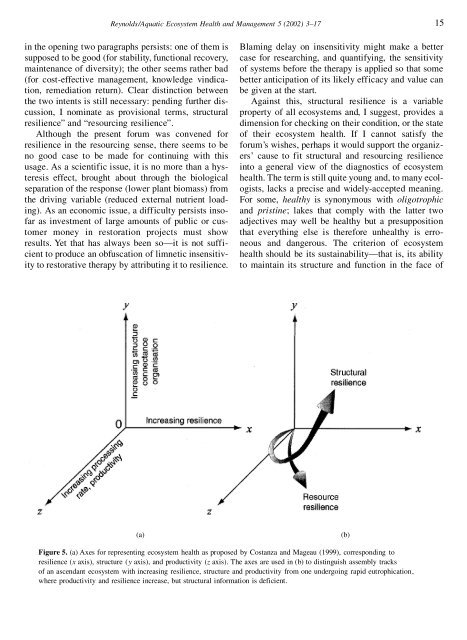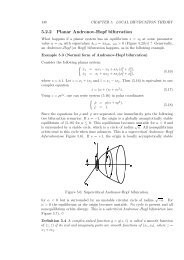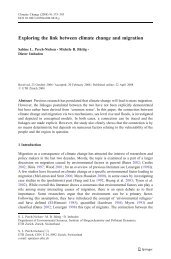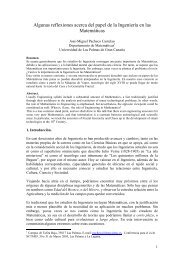Resilience in aquatic ecosystems - hysteresis, homeostasis, and ...
Resilience in aquatic ecosystems - hysteresis, homeostasis, and ...
Resilience in aquatic ecosystems - hysteresis, homeostasis, and ...
Create successful ePaper yourself
Turn your PDF publications into a flip-book with our unique Google optimized e-Paper software.
Reynolds/Aquatic Ecosystem Health <strong>and</strong> Management 5 (2002) 3–17 15<br />
<strong>in</strong> the open<strong>in</strong>g two paragraphs persists: one of them is<br />
supposed to be good (for stability, functional recovery,<br />
ma<strong>in</strong>tenance of diversity); the other seems rather bad<br />
(for cost-effective management, knowledge v<strong>in</strong>dication,<br />
remediation return). Clear dist<strong>in</strong>ction between<br />
the two <strong>in</strong>tents is still necessary: pend<strong>in</strong>g further discussion,<br />
I nom<strong>in</strong>ate as provisional terms, structural<br />
resilience” <strong>and</strong> “resourc<strong>in</strong>g resilience”.<br />
Although the present forum was convened for<br />
resilience <strong>in</strong> the resourc<strong>in</strong>g sense, there seems to be<br />
no good case to be made for cont<strong>in</strong>u<strong>in</strong>g with this<br />
usage. As a scientific issue, it is no more than a <strong>hysteresis</strong><br />
effect, brought about through the biological<br />
separation of the response (lower plant biomass) from<br />
the driv<strong>in</strong>g variable (reduced external nutrient load<strong>in</strong>g).<br />
As an economic issue, a difficulty persists <strong>in</strong>sofar<br />
as <strong>in</strong>vestment of large amounts of public or customer<br />
money <strong>in</strong> restoration projects must show<br />
results. Yet that has always been so—it is not sufficient<br />
to produce an obfuscation of limnetic <strong>in</strong>sensitivity<br />
to restorative therapy by attribut<strong>in</strong>g it to resilience.<br />
Blam<strong>in</strong>g delay on <strong>in</strong>sensitivity might make a better<br />
case for research<strong>in</strong>g, <strong>and</strong> quantify<strong>in</strong>g, the sensitivity<br />
of systems before the therapy is applied so that some<br />
better anticipation of its likely efficacy <strong>and</strong> value can<br />
be given at the start.<br />
Aga<strong>in</strong>st this, structural resilience is a variable<br />
property of all <strong>ecosystems</strong> <strong>and</strong>, I suggest, provides a<br />
dimension for check<strong>in</strong>g on their condition, or the state<br />
of their ecosystem health. If I cannot satisfy the<br />
forum’s wishes, perhaps it would support the organizers’<br />
cause to fit structural <strong>and</strong> resourc<strong>in</strong>g resilience<br />
<strong>in</strong>to a general view of the diagnostics of ecosystem<br />
health. The term is still quite young <strong>and</strong>, to many ecologists,<br />
lacks a precise <strong>and</strong> widely-accepted mean<strong>in</strong>g.<br />
For some, healthy is synonymous with oligotrophic<br />
<strong>and</strong> prist<strong>in</strong>e; lakes that comply with the latter two<br />
adjectives may well be healthy but a presupposition<br />
that everyth<strong>in</strong>g else is therefore unhealthy is erroneous<br />
<strong>and</strong> dangerous. The criterion of ecosystem<br />
health should be its susta<strong>in</strong>ability—that is, its ability<br />
to ma<strong>in</strong>ta<strong>in</strong> its structure <strong>and</strong> function <strong>in</strong> the face of<br />
(a)<br />
(b)<br />
Figure 5. (a) Axes for represent<strong>in</strong>g ecosystem health as proposed by Costanza <strong>and</strong> Mageau (1999), correspond<strong>in</strong>g to<br />
resilience (x axis), structure (y axis), <strong>and</strong> productivity (z axis). The axes are used <strong>in</strong> (b) to dist<strong>in</strong>guish assembly tracks<br />
of an ascendant ecosystem with <strong>in</strong>creas<strong>in</strong>g resilience, structure <strong>and</strong> productivity from one undergo<strong>in</strong>g rapid eutrophication,<br />
where productivity <strong>and</strong> resilience <strong>in</strong>crease, but structural <strong>in</strong>formation is deficient.






